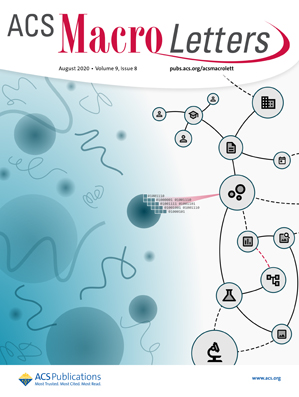Intracellular Generation of Alkyl Radicals Enabled by a Self-Catalytic ATRP Nanoinitiator.
IF 5.1
Q1 POLYMER SCIENCE
引用次数: 0
Abstract
Oxygen-independent alkyl radicals (R•) have demonstrated great promise in combating tumor hypoxia. Currently, Azo compounds have been the primary source of R•, suffering from external stimuli and decomposition during circulation. Herein, we developed a self-catalytic ATRP nanoinitiator that could generate R• via glutathione (GSH) reduction and thus selectively induce apoptosis of tumor cells. Specifically, a conjugation of laccase (possessing a copper(II) complex) and polymeric alkyl bromide, poly(iBBr), was fabricated to yield an ATRP nanoinitiator (Lac-P(iBBr)). After internalization by cells featured with overexpressed GSH, copper(II) in Lac-P(iBBr) was reduced to copper(I) by GSH, which abstracted the Br atom in poly(iBBr) to yield toxic R•. Moreover, GSH-depletion intensified the oxidative damage caused by R•. Efficient generation of R• by Lac-P(iBBr) could happen in lab flasks, living cells, and tumor-bearing mice without any external stimuli, as demonstrated by the radical product, as well as the consumption of GSH. Moreover, the self-catalytic ATRP nanoinitiator significantly induced cell apoptosis and suppressed tumor growth. Our study expands the chemical toolbox to manipulate cell fates.通过自催化 ATRP 纳米引发剂在细胞内生成烷基自由基。
不依赖氧气的烷基自由基(R-)在对抗肿瘤缺氧方面显示出巨大的潜力。目前,偶氮化合物一直是 R- 的主要来源,但会受到外部刺激并在循环过程中分解。在此,我们开发了一种自催化 ATRP 纳米引发剂,可通过谷胱甘肽(GSH)还原生成 R-,从而选择性地诱导肿瘤细胞凋亡。具体来说,我们将漆酶(具有铜(II)络合物)与聚合烷基溴(poly(iBBr))共轭,制成了一种 ATRP 纳米引发剂(Lac-P(iBBr))。Lac-P(iBBr)中的铜(II)被过表达 GSH 的细胞内化后,被 GSH 还原成铜(I),GSH 会抽取聚(iBBr)中的溴原子,生成有毒的 R-。此外,GSH 缺乏会加剧 R- 造成的氧化损伤。Lac-P(iBBr)可以在实验室烧瓶、活细胞和肿瘤小鼠体内高效生成R-,无需任何外部刺激,自由基产物以及GSH的消耗都证明了这一点。此外,自催化 ATRP 纳米引发剂能显著诱导细胞凋亡并抑制肿瘤生长。我们的研究拓展了操纵细胞命运的化学工具箱。
本文章由计算机程序翻译,如有差异,请以英文原文为准。
求助全文
约1分钟内获得全文
求助全文
来源期刊
CiteScore
10.40
自引率
3.40%
发文量
209
审稿时长
1 months
期刊介绍:
ACS Macro Letters publishes research in all areas of contemporary soft matter science in which macromolecules play a key role, including nanotechnology, self-assembly, supramolecular chemistry, biomaterials, energy generation and storage, and renewable/sustainable materials. Submissions to ACS Macro Letters should justify clearly the rapid disclosure of the key elements of the study. The scope of the journal includes high-impact research of broad interest in all areas of polymer science and engineering, including cross-disciplinary research that interfaces with polymer science.
With the launch of ACS Macro Letters, all Communications that were formerly published in Macromolecules and Biomacromolecules will be published as Letters in ACS Macro Letters.

 求助内容:
求助内容: 应助结果提醒方式:
应助结果提醒方式:


